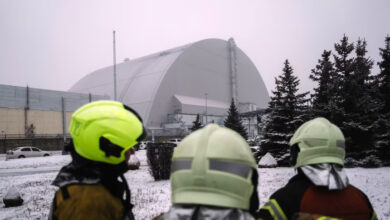
Exclusive content:
At the upcoming global stocktake at COP28, the UN’s annual climate change conference, the world’s attention will focus on a single goal: we have just six years to reduce carbon emission emissions by 43 percent. To keep global warming to 1.5°C above pre-industrial levels, total emissions must peak in 2025, and then drop by nearly half by 2030, according to the Intergovernmental Panel on Climate Change.
There is an urgent need for quick and decisive action towards our net-zero goals. If we are to step up and create the world that we can thrive in, investing in the planet is the best way to secure both the future of our businesses and the welfare of life on Earth.
And the time is now.
We already have the tools available to drive sustainable outcomes and support long-term positive change. Digital technologies stand alongside strategic approaches in embedding sustainability in industrial value chains.
In fact, three out of four executives (76 percent) believe emerging technologies can play a critical role in reducing their organization’s carbon emissions, according to a 2023 EY survey.
What’s more? What’s good for the planet is good for business.
Make no mistake. Investing in digital technologies offers the opportunity to reap business dividends along with driving positive sustainability outcomes. We see time and again that companies that prioritize sustainability outperform those that don’t.
Capgemini research shows that from 2020 to 2021, sustainability frontrunners – the top 11 percent of companies surveyed – were realizing 83 percent higher revenue per employee compared to the average. Meanwhile, more than a quarter (26 percent) of the least advanced were 13 percent below the average.
Digitalization is already helping accelerate the decarbonization of industry. Technologies based on smart data, machine learning, artificial intelligence and predictive maintenance are transforming the industrial sector and sparking ingenuity by connecting people with trusted information and insights to drive responsible use of the world’s resources.
Companies are seeing that investing in accelerating net-zero targets and environmental priorities can simultaneously improve business outcomes and boost their bottom line. The benefits include:
- Improved emissions modelling together with quicker decisions: With a single integrated software suite incorporating CO₂ modelling capabilities, global energy leader BP can make quicker and faster decisions. Analysts can now see compiled operational data and make informed decision in just three minutes rather than seven hours. At the same time, improved CO₂ emissions modelling capabilities help plan, test and evaluate strategies for cutting carbon emissions.
- Driving energy efficiency while saving millions: The University of California, Davis uses a cloud-based data management system to track and bring down their emissions. By collecting real-time data on its energy usage, UC Davis is on track to be carbon neutral by 2025. On just one front – shifting from traditional hot water systems to low-temperature hot water heating – its campus will save an estimated USD$197 million over 60 years. This operational improvement would not have been possible had data from across the campus not been centralized for analysis.
- Conserving water by innovating on the go: The water sector accounts for 7 percent of global energy consumption and generates three-10 percent of total greenhouse gas emissions. In Gwinnett County, Georgia, the Department of Water Resources brought together one platform, data from two water production plants, 8,000+ miles of distribution and transmission networks, hundreds of water collection points, and three water reclamation facilities so it could be viewed in one window on any device, on-site or offsite. One optimization alone has led to 120 million gallons of water and US $35,000 saved per year.
Net-zero can deliver net profits.
It is results like these, when scaled up, that will help us achieve the International Energy Agency’s (IEA) net-zero trajectories faster. That’s why the next step on the road to decarbonization requires expanding the gains from digital technologies within an organization, across the entire value chain to include external stakeholders.
Businesses that are linked to each other support mutual collaboration, innovation and critical thinking. By pooling enterprise data internally and externally on a single cloud-based platform, value chain partners can realize unprecedented economies, synergies and benefits for their own organizations and for society.
In California, for example, energy consulting firm ZGlobal and its business partner, Silicon Valley Clean Energy, share real-time and historical operations data in a secure, connected community. A holistic view of the entire value chain has enhanced system-wide security and energy traceability. All of this while saving thousands of dollars on power purchases and with future projects in the pipeline, accelerating North America’s low-carbon energy transition.
This kind of connected intelligent network – also known as a connected industrial ecosystem – helps foster continued innovation, drive systemic efficiency and decarbonization without sacrificing security, reliability or affordability.
Those are the sort of goals almost nine out of 10 (87 percent) international business executives have an eye on as they increase investment in industrial digital solutions this year. In a recent AVEVA survey, senior leaders at industrial companies across the globe with annual revenues of over US$50 million, cited their main priority is intelligent data that can help them tackle geopolitical and economic challenges as well as growing climate change.
In real-time data sharing communities, everybody wins.
As the next step in harnessing technology’s potential, connected industrial ecosystems can drive the exponential impact we need to secure the triple bottom line: profit, people and planet.
It becomes clearer with each day that extreme weather events are reflecting the impact of our actions. The UN forecasts that avoiding the worst impacts of human-caused climate change could require US$4.3 trillion a year by 2030, with costs only likely to escalate as warming continues. Clearly, inaction is no longer an option.
We may not be able to reverse existing climatic conditions, but we can mitigate future damage while helping repair the planet, adapting to life in a warming world, and making sure communities everywhere continue to have the power, water and food they need.
With discussions at COP28 – focused on the urgent need to close the sustainability gap over the next few years, we must step up to invest in the green economy. Doing so is the only way to create a thriving future for everyone. We owe that to not only ourselves, but also to the next generation.




